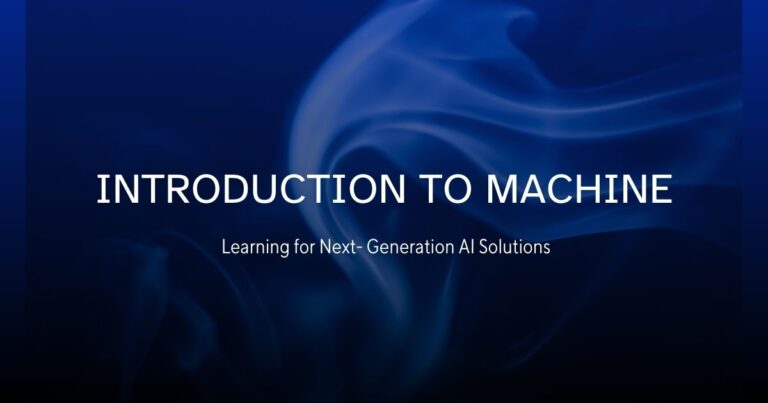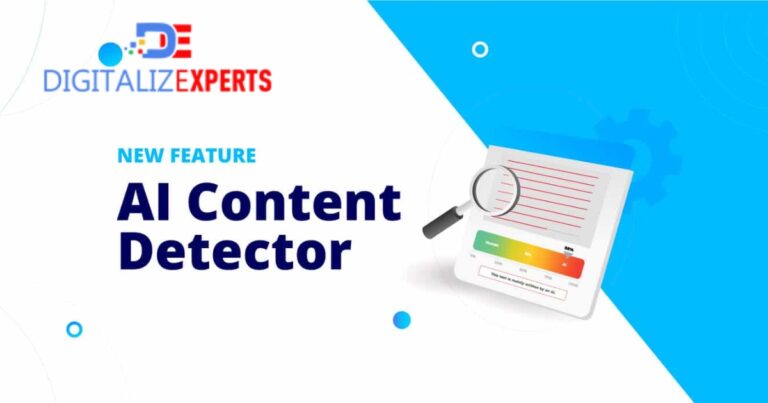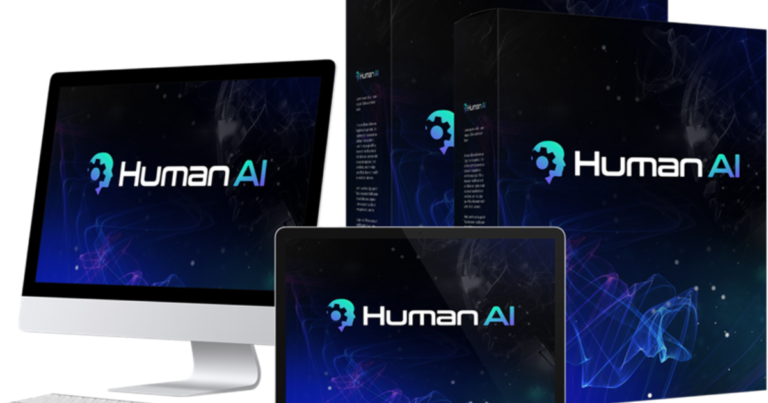Key Highlights
- Artificial intelligence (AI) lets computers act like people by doing things such as data analysis, natural language processing, and machine learning.
- The main types of AI include narrow AI, general AI, and super AI. You can see these in things like virtual assistants and facial recognition.
- Many AI technologies help with big changes at this time. Deep learning, neural networks, and reinforcement learning all make big things happen in many areas.
- AI is a part of our day-to-day lives in ways like customer service bots, self-driving or autonomous vehicles, and recommendation systems you get on streaming and shopping sites.
- AI can help us solve complex problems, but there are also ethical questions. These include worries about bias or data privacy.
- New ideas, like generative AI and adding AI into robots, keep changing how the world and many industries work and grow.
Introduction
Artificial intelligence, or AI, is changing the way we use technology. Machines are now able to act like people and solve hard problems that used to need human intelligence. This is because of new steps forward in machine learning, data analysis, and natural language processing. These things help computers do work that only people could do before.
With artificial intelligence, you see changes in healthcare, retail, and other industries. AI also helps in daily life by giving people personalised tips and ideas. From its basics to the ways it gets used, you can see that AI does a lot to make things smarter all over the world. Through machine learning, data analysis, and natural language work, artificial intelligence helps people get better answers and make life easier.
Understanding Artificial Intelligence: The Basics

intelligence is a way to help computer systems do things that people can do with their minds. These things include understanding language, making choices, creating art, and solving problems.
At the center of it, artificial intelligence brings together human intelligence and the speed of computer systems. It looks at big sets of information to complete tasks with great care. These are tasks that could be too much for one person to handle. With each new bit of information, artificial intelligence can adjust and change how it works. When we mix human thinking with the power of artificial intelligence, we can make new discoveries in many areas.
Defining Artificial Intelligence in Everyday Language
Understanding artificial intelligence does not have to be hard. You can think of it as computer systems made to do different jobs that people often do, like thinking and making choices. With artificial intelligence, devices can “learn” from what has happened before, spot patterns, and handle changes by themselves. This means people do not have to give it new commands all the time.
For example, look at virtual assistants on your phone like Siri or Alexa. These AI tools listen to what you say, find the right information, and do things for you. They can make a call or play music almost right away.
This idea is bigger than digital helpers. Artificial intelligence is in facial recognition, the suggestions you get on streaming sites, and in cars that drive themselves. Computer systems that use artificial intelligence do more than just follow orders. They can deal with things they did not expect and get better with time. In short, AI helps machines to think and work with us. It makes our lives easier by helping us with various tasks.
How AI Differs from Human Intelligence
Both artificial intelligence and human intelligence can solve problems. But they do this in different ways. Human intelligence comes from a mix of your thinking skills, feelings, and learning over time. This helps people come up with new ideas and think in creative ways.
Artificial intelligence is not the same. It follows set rules and programs. It does not have feelings. AI depends on big amounts of data to learn and figure things out. Unlike people, AI can look at a huge amount of information and finish many tasks very fast. It does not need to stop to rest.
Humans have a special way of changing how they think by using their skills, background, and feelings. AI systems can copy some ways of learning and thinking, but they can only work within the limits set by their computer code. Artificial intelligence is very good at doing things over and over again where you need everything to be done just right. But human intelligence is better at dealing with things like care for others and doing what is right—these things are needed for friendship and coming up with new things. In the end, while AI is good at helping people, it does not copy the rich and deep ways humans think.
A Brief History of Artificial Intelligence

of artificial intelligence goes back to 1955. That is when John McCarthy came up with the name. At the time, he was an assistant professor in mathematics. His goal was to make machines that could think and solve problems like people. He wanted these computers to help people do things better.
From the very start, ai development has found a home in computer science. This field helped artificial intelligence grow from an idea into tools we can use every day. Now, artificial intelligence is moving fast. It is changing the way people work in many fields. It also affects our lives and the world more than McCarthy could have ever thought possible.
Early Developments and Key Milestones
The journey of artificial intelligence started with new ideas that changed how people think about technology. In the early days, work on artificial intelligence was about making systems that could use signs and do simple logic. Alan Turing is well known for asking, “Can machines think?” His famous paper set the base for much of the research in this field.
A big moment happened in 1956 at the Dartmouth workshop. McCarthy made artificial intelligence become known as a real science. This event helped bring new things like Logic Theorist, a program built by Allen Newell and Herbert A. Simon. That program could help to solve math problems.
By the 1990s, artificial intelligence had started to get into more everyday things. IBM’s Deep Blue is one big example. It defeated Garry Kasparov, who was a world chess champion. These moments gave a strong base to newer ideas, like neural networks and deep learning. These changes helped to shape our world and how some of its most important industries work today.
AI’s Growth Over Recent Decades
Over the last few years, artificial intelligence has changed a lot. This happened because there is more big data and computers now have more power. Machine learning and deep neural networks are two things that have made some of the biggest changes. With these, we now have autonomous vehicles, AI-powered tools to help doctors, and smart assistants like Siri and Alexa.
A big reason for this fast growth in artificial intelligence is because there is now so much data out there. For example, Netflix uses ai algorithms and big data to suggest shows or movies that match what you like. This is only possible because they have a lot of data about everybody’s choices.
Now, artificial intelligence has grown even more. It uses real-time analytics and tries to guess what will happen next in many fields like finance and healthcare. As computers got faster, and their processors got better, AI grew to be a key tool for work and everyday life for people and companies everywhere.
The Main Types of Artificial Intelligence
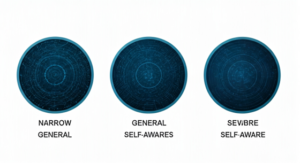
intelligence comes in three main types. There is narrow AI, general AI, and super AI. Each one can do different things and think in different ways. This shows how far artificial intelligence can copy what people do.
Narrow AI, sometimes called weak AI, is really good at a few specific tasks. For example, it can help you with virtual assistants or with recommendation systems. General AI tries to be as smart as human intelligence. But this one is still not real and is just an idea for now. Super AI is the idea that an AI could do more than human intelligence. It brings up many big questions about the future and what is right or wrong. All together, these types show the whole range of what artificial intelligence can do.
Narrow AI vs. General AI
Narrow AI, sometimes called weak AI, is made to work well in certain situations. It can only do the tasks it was designed to do. For example, virtual assistants like Siri or ChatGPT are great at talking with people, but they cannot do other jobs outside this. Narrow AI does not have general thinking skills. The “learning” it does is only in the areas planned for it by its makers.
General AI is very different and is sometimes called artificial general intelligence, or AGI. It is meant to have flexible thinking, much like how people think. This means it could solve many kinds of problems, not just one. But right now, this kind of AI does not exist. It is still something scientists and tech experts hope to make one day.
Today, narrow AI is used in customer service and in suggesting shows on streaming sites. These are tasks that help people but are done within a fixed setup. General AI, however, gets people talking about what could happen if machines start thinking and changing on their own. There is hope that one day, machines could be more like us in how they understand and work with many types of information. The line between narrow AI and general AI helps lead research to find out new things and maybe let AI reach its full potential.
Reactive Machines, Limited Memory, Theory of Mind, and Self-Aware AI
Understanding the different types of AI helps you see how these systems work with the world. Reactive machines are the simplest type of artificial intelligence. They only work by set rules and do not have memory or learn from what they have done. Limited memory AI can use what it learns from the past to do better in some specific tasks. A more advanced kind is called theory of mind AI, which tries to understand human emotions and what people want or feel. The most advanced type would be self-aware AI, which is still just a theory. This type would know itself in a way like people do, which would be a huge change in artificial intelligence.
Core Technologies Behind AI
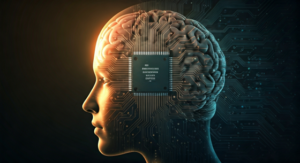
intelligence is based on a few key technologies. At the center of it is machine learning. This type of learning has parts like unsupervised learning and reinforcement learning. These let a system use data to get better with time. Neural networks help machines act a bit like people. They can spot complex patterns and handle big sets of data. Deep learning is a subset of machine learning. It uses many layers to be good at things like image recognition and working with natural language. All of these tools come together to make artificial intelligence stronger. As a result, they help give more accurate predictions and better user experiences in many places.
Machine Learning Explained Simply
Understanding machine learning means knowing how computer systems use data to get better over time. Machines do this by looking for complex patterns in data. They make guesses or choices without needing to be told each step. In machine learning, there are different ways to help computers learn. These ways include supervised learning, unsupervised learning, and reinforcement learning. Each of these methods helps to solve specific tasks.
Artificial intelligence uses machine learning to give us things we use every day. Some examples include recommendation systems, fraud detection, and image recognition. Using these methods, computer systems can do jobs faster and with more accuracy. As machine learning gets better, we see it more and more in different parts of life. Its growth helps all of us by making things easier, improving how we work, and making our experiences better.
Deep Learning and Neural Networks
A good understanding of deep learning and neural networks shows their important part in growing artificial intelligence. Deep learning is a type of machine learning that uses many layers of neural networks to find complex patterns in big groups of data. These networks work like the way people think, so they help with things like image and speech recognition. By using more computational power and better algorithms, deep learning can get better at its work over time without someone having to program every step. This makes it very useful in many areas, like customer service chatbots and strong fraud detection tools. The progress with deep learning shows how artificial intelligence can help us solve more complex problems.
Natural Language Processing in Action
Understanding how natural language processing (NLP) works in real situations shows how big its impact can be. At its heart, NLP uses machine learning and machine learning algorithms to study and understand natural language. This helps systems talk with people in a way that is helpful. You can see this in things like chatbots that make customer service better and in tools that learn what people feel or think from what they write online.
New models use deep neural networks and neural networks to make sense of language in even more advanced ways. This allows for hard jobs like translating one language to another and creating new content. This ongoing change in natural language processing and machine learning keeps moving the AI world forward. Now, there is room for even smarter ways to use data to help people and companies connect in better ways.
Common Applications of AI in Daily Life

Today, many industries use artificial intelligence in daily life, which changes the way people talk to and use technology. Voice assistants, like Siri and Alexa, use natural language processing so they can understand what you say. This makes customer service smoother and lets you do things without your hands. At the same time, platforms like Netflix and Amazon use recommendation systems that look at your actions to show you things you may like. This makes your experience better. In healthcare, ai algorithms help make better treatment plans and predict how patients will do. This shows how artificial intelligence is helpful in many different ways, and how it can help solve complex problems.
AI in Virtual Assistants and Chatbots
Virtual assistants and chatbots are changing the way we use technology every day. These tools use natural language and machine learning algorithms to understand what you say and give the right answers. They use natural language processing to listen to your requests and machine learning to get better as you use them more. By looking at data in real-time, they make customer service faster and help with many tasks. As these AI systems become better, they learn more from each person. They can change to match what you like and even notice your human emotions. This makes using them feel more personal and useful.
The growth of AI is making your experience easier and better. It also helps business operations become smoother and smarter. Because of this, virtual assistants and other AI tools are now important for any business in today’s world.
Personalized Recommendations (Streaming, Shopping, etc.)
Giving people tailored suggestions has changed how they use different platforms. You can see this in streaming services and online shopping. These systems use artificial intelligence and machine learning algorithms to look at customer data. They figure out what people like, and then make the experience more personal for them.
Recommendation systems are a big part of this. They use things like collaborative filtering and deep learning. This helps to guess what a person might choose next, which makes users happy and can also help increase sales.
All of this is possible because of data analysis made better with artificial intelligence, machine learning, and deep learning. This has not just made the experience better for users. It also helps businesses learn more about what people want. This shows how much impact artificial intelligence, data analysis, and other tools can have on the choices that people make every day.
How Does AI Work? A Beginner’s Guide
AI works by using algorithms and handling data. The machines look at patterns. They learn from these patterns to guess what will happen or make choices. As AI studies big groups of data, it gets better at what it does over time. This helps it do things like language understanding and image recognition really well.
What You’ll Need to Get Started with AI
Jumping into artificial intelligence starts with a good base of resources and knowledge. You need to know some programming. Python or R are some of the main options, and these are needed for the use of ai algorithms. Knowing how to do some basic statistical analysis, the main parts of data science, and simple machine learning ideas will help you handle complex problems. These skills make it easier to get into this area.
You can also use online courses and join different communities for artificial intelligence. This can give you support and advice when you need it. Use ai tools like TensorFlow or PyTorch, as they let you work with real examples. This helps you learn more and get better at ai development. Using all of these will set you up well in the world of artificial intelligence.
Essential Resources: Courses, Tools, and Communities
There is so much knowledge out there when you learn about artificial intelligence. You can start by taking online courses. Sites like Coursera, edX, and Udacity have steps you can follow if you are new. These online courses show you how to begin and what to do next. While you learn, you also get to use ai tools like TensorFlow and PyTorch. These tools help you try out machine learning and neural networks for yourself.
You can also join groups online, like on Reddit or other forums, to talk with people about artificial intelligence. Working with others helps you get support, better ideas, and real ways to use machine learning algorithms. If you want even more for your ai development, you can watch webinars with industry experts. This is a great way to learn new things, get motivated, and keep growing in this field.
Step-by-Step Guide: Exploring AI for Beginners
Starting to learn about artificial intelligence can be broken down into a few clear steps. First, think about what parts of artificial intelligence you want to get to know, like natural language processing or machine learning algorithms. Then, get to know the basic words and ideas in this area. This will help you build a strong base to learn more later. After that, look for beginner courses on topics like natural language and machine learning. Most of these classes will show you how to use some ai tools, which lets you see how things work. Next, join some online groups. You will meet people who also want to learn and you can talk about these ideas or ask for help. Doing these things will help you get into the world of artificial intelligence in a steady and sure way.
Step 1: Choose an Area of Interest in AI
Choosing an area you like in artificial intelligence can open up many exciting chances. There are many different things you can do in this field, like natural language processing or computer vision. It is important to pick something you like, so you are excited to learn. You might want to try out machine learning, which has parts like supervised learning or unsupervised learning. Or, you could look into deep learning, where neural networks are very important. Each of these helps you get to know what AI can do, like making customer service better with chatbots or doing a new kind of data analysis. It is a good idea to go after what you want the most. That way, you will stay interested and learn even more.
Step 2: Learn the Basic Concepts and Terminology
Understanding basic ideas and words is key when you start out with AI. First, learn some important terms. “Artificial narrow intelligence” is AI made to do specific tasks. “Machine learning” is a part of AI that lets computers learn from data. “Deep learning” and “neural networks” help computer systems find complex patterns. Learning about “natural language processing” will help you know how AI deals with human language. If you use good resources for beginners, you will make your knowledge stronger in this new area.
Step 3: Enroll in Introductory AI or Machine Learning Courses
Learning about artificial intelligence can be very exciting, especially when you start with a formal class. The first courses in AI or machine learning give you a strong start. You will learn about main ideas like neural networks and reinforcement learning. Try to find classes or programs that let you work on hands-on projects. This helps you use what you learn in real-life situations. There are many online sites where you can study. These let you pick your own schedule and style of learning. When you join these courses, you get a better understanding of artificial intelligence. You can also meet other learners and industry experts. This gives you chances to work with others and grow in the field.
Step 4: Experiment with Beginner-Friendly AI Tools
Trying out easy-to-use AI tools is a good way to start learning about artificial intelligence. The platforms that you find online help you to get hands-on experience with simple ideas of AI. You can begin with AI development tools that make it easy to work with machine learning and neural networks. These tools often have simple controls and helpful instructions. They may also have ai tools with built-in models for tasks people do often. This helps you see how ai algorithms work. When you try new things with these resources, you can figure out how core features work, like natural language processing, which lets the computer understand human words. This way, you get a better idea of artificial intelligence, natural language, and the basics of ai development.
Step 5: Join Online AI Communities and Forums
Being part of online AI communities and forums is a great way to learn and work with others. When you talk to people who share your interest, you get to know more about machine learning, artificial intelligence, and different AI tools. You also learn from their stories and what they know. On these sites, you will often see people talk about ethical considerations, problems, and new things happening in the field. This helps everyone grow and get better in what they do. Sharing your thoughts on these forums helps you get better
at thinking and solving problems, too. It keeps you up to date with all the fast changes happening in artificial intelligence.
Major Benefits of Artificial Intelligence
Artificial intelligence helps people work faster and get more done in different industries. When businesses use ai tools to do tasks that happen over and over, their teams can spend more time thinking about difficult problems and coming up with new ideas. Also, machine learning algorithms help to make accurate predictions. This lets people use data to make better choices. It makes things run better and can help in areas like healthcare and finance.
Good customer service is important. AI chatbots and virtual assistants can talk to people and help answer questions. This gives users a better experience.
All in all, artificial intelligence brings new chances for people to grow and makes work easier. These changes show just how big an effect AI can have on work and in our daily lives.
Increased Efficiency and Productivity
Automation with artificial intelligence makes work smoother and helps businesses run better. When companies use machine learning algorithms, they can go through a lot of data. This helps them make better choices and get things done in less time. AI tools take care of simple, boring tasks. This lets people use their creativity and thinking skills on bigger plans. Putting artificial intelligence into areas like healthcare and finance makes everything work faster and better. It brings real growth and helps their teams stay on top of complex problems. With the help of machine learning and accurate predictions, companies make good choices, finish jobs quicker, and keep their service quality high for everyone.
Enhanced Problem-Solving Capabilities
One of the most important benefits of artificial intelligence is its better problem-solving skills. Artificial intelligence systems use machine learning algorithms and deep learning to look at a lot of data and find patterns. Some of these patterns may be hard for people to see. This helps people make better decisions by using good data analysis across different areas like healthcare and finance. Also, ai tools can make things work better and more correctly because they use real data. As machine learning and data analysis keep getting better, many industries use artificial intelligence now to find new ways to fix their big problems. These changes are making a difference in how we look at and fix problems today.
Challenges and Limitations of AI
There are many challenges and limits in artificial intelligence. One big concern is about ethical issues and bias in ai algorithms. These biases often come from the training data and can lead to unfair or wrong results in things like healthcare and customer service. Privacy worries add to the problem since the way data gets collected and used has raised a lot of talk about data privacy in ai development. The large amount of computational power needed is another problem. This can make it hard for everyone to use these new technologies and may leave some groups out. It is important to address these hurdles to make sure that artificial intelligence is used in a good and fair way.
Ethical Concerns and Bias in AI
Addressing ethical concerns and bias in ai algorithms is important for responsible growth. When there is bias in an algorithm, it can change results. This can lead to unfair choices in things like hiring, law enforcement, and healthcare. If there is not enough different training data, these problems can get worse and make it even harder for ai algorithms to be fair. It is key to think about human values and feelings to help ai algorithms better help people and society. By dealing with these issues, we make sure ai systems treat all users fairly and that there is more honesty and responsibility in how they are used.
Security and Privacy Issues
As more people use artificial intelligence, there are more worries about security and privacy. AI uses a lot of data, and this can put sensitive information at risk if it is not kept safe. If a data breach happens or someone who should not have access gets personal information, it brings up ethical considerations. People want to know how their information is used, and get a say in it. There is also the risk that biases in the algorithm can lead to unfair results, so it gets harder to keep privacy safe. Strong security, such as using encryption and following privacy rules, is needed to build trust in artificial intelligence. These steps help stop problems that happen when data gets misused.
Emerging Trends and the Future of AI

There have been big steps forward in generative ai models. These new tools are now changing the world of artificial intelligence. The models can make things like text, pictures, and even music. The way they do this is getting closer to human creativity. This is because of deep learning, neural networks, and other machine learning ways that help them learn.
The use of artificial intelligence in autonomous vehicles is also changing how people move. Using machine learning algorithms, these cars can understand and act on complex data on the go. This helps make roads safer and traffic run better.
The future of ai looks bright because computers keep getting more powerful. With more computational power, we can look forward to even more useful applications in many different areas. This will affect the way we live, how we work, and how we use technology every day.
The Rise of Generative AI Models
There has been a big change in technology with the rise of generative AI. This new way of working is changing how we solve problems. Generative AI uses deep learning and neural networks. With these tools, it can make new things like text, images, or music. The systems look at huge sets of data. They find complex patterns in what people do or say, and then they can make outputs that seem like they were made by humans.
As this technology grows, generative AI has more uses. You will see it in entertainment, healthcare, and education. The way these tools work now, and the way they will grow, shows that generative AI will have a big effect on future inventions and how people use tech.
AI in Autonomous Vehicles and Robotics
Incorporating AI into autonomous vehicles and robotics has changed the way people move and work in many industries. Advanced algorithms let these systems look at huge amounts of data in real time. This helps them improve how they move and makes things safer. Machine learning helps with predictive maintenance. Because of this, robots can run smoothly and work better, making people more productive.
Natural language processing helps people talk to machines, so voice-assisted tools are now common in many vehicles. As people make progress with deep learning and image recognition, these machines get better. The systems are now smarter and respond fast. They also act more like human intelligence, making the machines better all the time.
Conclusion
The way artificial intelligence is changing the world cannot be ignored. It keeps on growing and is being used in many fields. By using the right tools and smart programs, AI is helping us to solve complex problems and get more work done in less time. As this technology gets better each year, it is important to stay up to date about what AI can do and to think about any ethical considerations. Learning about AI by joining online communities or using different platforms can help people understand it well. This allows each one of us to be part of building new ideas in AI. When we keep up with these changes, we are ready for a future where artificial intelligence is going to be a big part of our lives and the world.
Frequently Asked Questions
Can I learn AI without a technical background?
Yes, you can learn about artificial intelligence even if you do not have a technical background. There are many online courses and other resources that break down hard ideas. This makes them easy for beginners to follow. You should focus on the basic parts first. Try to join online groups made for people like you, as they help you learn and build skills in artificial intelligence.
What are the best free resources for AI beginners?
Beginner-friendly resources are easy to find online. Websites like Coursera, edX, and Khan Academy all offer free AI courses. Sites like Google AI and Fast.ai also have tutorials that help you learn step by step. There are forums, too, like Reddit and Stack Overflow, that let people ask questions and get support from others. These options all help people get started with AI.
How is AI impacting jobs and the workforce?
AI is changing the way we work. The technology can do many tasks that people use to do over and over again. This means the jobs in tech and other industries will be different. Some jobs might not be there in the future, but there will be new chances for people to work with AI. The good news is that AI helps people do their work faster. It lets them spend more time on hard and creative projects.
Is AI safe to use in everyday life?
AI is usually safe to use in your day-to-day life. But it is important to know about any possible risks like privacy issues and the safety of your data. You should always find out how AI apps use your info. Make sure you use trusted platforms for this.
For More Post to Read click the Link : Supergrow.ai

